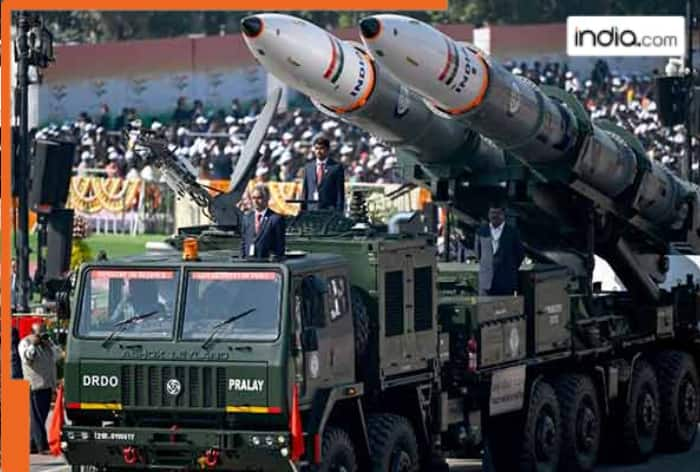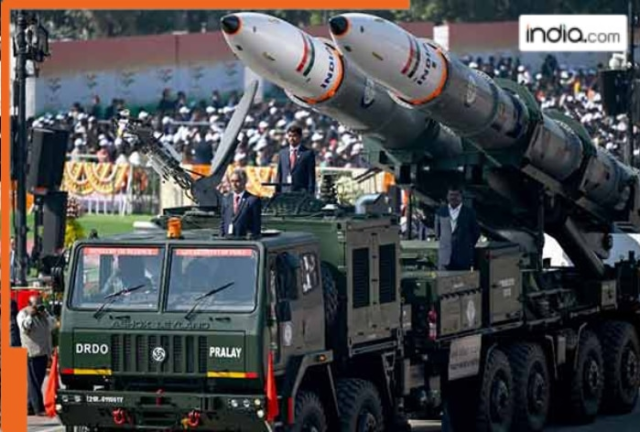Designed for the Indian Army, Pralay is a road-mobile, short-range ballistic missile that can strike with devastating effect.

In the evolving game of modern warfare, India has fielded two powerful weapons that strike fear into the hearts of its adversaries—the Pralay tactical ballistic missile and the Rudram series of radar-killing air-launched missiles. But when the stakes are high, and the enemy must be stopped in their tracks, which missile proves to be more effective?
Let’s break it down.
Pralay: India’s Tactical Powerhouse
True to its name—“Pralay” means Apocalypse in Sanskrit—this missile delivers sheer destructive force with stunning speed and precision. Designed for the Indian Army, Pralay is a road-mobile, short-range ballistic missile that can strike with devastating effect.
Key Features:
- Range: 150–500 km
- Warhead: 500–1,000 kg (HEPF, PCB, RDPS types)
- Speed: Terminal velocity up to Mach 6.1
- Precision: Less than 10 meters CEP
- Launch Time: Ready to fire within 60 seconds of command
Originally developed to counter threats like China’s Dongfeng-12 and Pakistan’s Nasr, Pralay gives India a potent conventional missile not bound by nuclear No First Use constraints.
Operational Edge:
- 250 missiles ordered by the Indian Army (₹7,500 crore)
- 120 ordered by the Air Force (₹14,000 crore in 2022)
Rudram: India’s Air-Launched Radar Hunter
If Pralay is the hammer, Rudram is the scalpel. This series of air-to-surface anti-radiation missiles is designed to destroy enemy radar systems, rendering their air defences useless.
The Rudram Line-up:
- Rudram-1: First indigenous ARM, 250 km range
- Rudram-2: 300–350 km range, dual role (radiation + ground attack), Mach 5.5
- Rudram-3: 550–600 km range, 200 kg warhead, highly maneuverable
- Rudram-4: (Under development) Range of 1,000–1,500 km, hypersonic
Designed For:
- SEAD & DEAD missions: Suppression/Destruction of Enemy Air Defenses
- Precision strikes with minimal collateral damage
- Standoff capabilities from beyond enemy SAM (surface-to-air missile) range
- Compatible with multiple aircraft platforms
Missile vs Missile: A Strategic Face-Off
For Immediate Battlefield Dominance — Pralay Wins
- Faster to deploy: Road mobile, independent of aircraft
- Heavier payloads: Up to 1,000 kg vs Rudram’s 200 kg
- Rapid firepower: Twin missile canisters for sequential strikes
- All-weather operations: Not dependent on flying conditions
Bottom Line: Ideal for high-intensity, short-duration conflicts—strike hard, strike fast.
For Long-Term Strategic Gains — Rudram Wins
- Precision Targeting: Pinpoint attacks on radar and command centers
- Airspace Advantage: Neutralizes enemy detection systems
- Deep Penetration: Launched from jets at safe distances
- Flexible Deployment: Works across multiple platforms, including Su-30MKI and Tejas
Bottom Line: Perfect for preparing the battlefield and gaining air superiority.
The Final Word: It’s Not Either-Or — It’s Both
The choice between Pralay and Rudram isn’t about one being better—it’s about using both in harmony. When deployed together:
- Rudram blinds the enemy by destroying their eyes (radars)
- Pralay crushes their backbone by destroying strategic infrastructure
This dual strategy ensures that adversaries are not just weakened—but completely paralyzed.
As India moves toward building an Integrated Rocket Force, missiles like Pralay, along with Rudram, BrahMos, Pinaka, and Nirbhay, will be central to our defense doctrine.
In Conclusion:
If the battle begins today, Pralay will dominate the battlefield. If it’s a drawn-out war of attrition, Rudram will ensure airspace superiority. But in any scenario, India’s adversaries must be ready to face both simultaneously—a challenge few can survive.
———E.O.M

















































